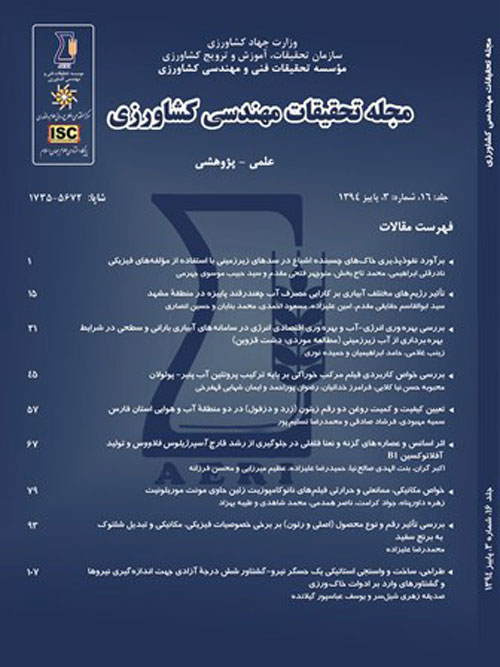Using a Rod-Digger to Dig Onion Bulbs in Dense Planting
Abstract:
Corresponding Author: Academic member, Agricultural Engineering Reaserch Department, Isfahan Agricultural Research Center, Isfahan, Iran. P. O. Box: 81785-199. E-mail: orangtaki@yahoo.com Received: 11 June 2012, Accepted: 29 December 2012In Iran, onion plants are currently broadcast over the majority of onion fields and weeding and harvesting are done manually by seasonal workers. At harvest time, 40 worker-days are required to onion dig just one hectare. This cost could be saved if the operation could be carried out by machine. Rear-mounted diggers can only be implemented if 40 cm spacing between rows is allowed for each tractor wheel, which results in a 20% decrease in yield. This research evaluated the feasibility of using front-mounted implements to digrows of crop bulbs of the same width as the tractor and to dig only two narrow bands in front of the tractorwheels. Treatments included installing a rod weeder (rod digger) with attached wind rowers in front of the tractor and a rod-digger at the rear of the tractor. Furrowers were attached in front to dig bulbs located in front of the tractor wheels. The feasibility of the treatment applications was evaluated in preliminary field tests where machine performance indices were measured. The effect of machinery treatments and leaftopping before digging on loss and mechanical damage were tested in a typical onion farm in Isfahan province. The results showed that the working depth of the rod digger installed in front of the tractor without a draft control system was not consistent and damaged 8% of bulbs mechanically. Moreover, insufficient maneuverability of the tractor and a percentage of slippage of the drive wheels were other restrictions to application of the front-mounted rod digger. Connecting the rod digger to the rear linkage of the tractor and using two furrowers in front of the tractor wheels was the only configuration for use of such implements in densely planted onions. In this configuration, using foreword tines like moldboard furrowers in front of the tractor was not easy without the use of a draft control system because of the non-uniformity of the working depth. Disk plows worked at a relatively uniform depth without the need for a draft controller; slippage and maneuverability of the tractor were also satisfactory. A comparison of the two furrowers in front of the tractor showed that the disk-type furrower caused less loss to the outer layer of the onion bulbs. The drawback to this type was a 4% loss from cut bulbs that emerged in front of the vertical cutting edge of the disk. If just a 20 cm space is provided on the either side of the planted band, a disk furrower attached in front and a rod digger in the rear of a tractor is the recommendable configuration for onion digging under the tested conditions.
Keywords:
Language:
Persian
Published:
Journal of Agricultural Engineering Research, Volume:14 Issue: 2, 2013
Page:
93
magiran.com/p1173997
دانلود و مطالعه متن این مقاله با یکی از روشهای زیر امکان پذیر است:
اشتراک شخصی
با عضویت و پرداخت آنلاین حق اشتراک یکساله به مبلغ 1,390,000ريال میتوانید 70 عنوان مطلب دانلود کنید!
اشتراک سازمانی
به کتابخانه دانشگاه یا محل کار خود پیشنهاد کنید تا اشتراک سازمانی این پایگاه را برای دسترسی نامحدود همه کاربران به متن مطالب تهیه نمایند!
توجه!
- حق عضویت دریافتی صرف حمایت از نشریات عضو و نگهداری، تکمیل و توسعه مگیران میشود.
- پرداخت حق اشتراک و دانلود مقالات اجازه بازنشر آن در سایر رسانههای چاپی و دیجیتال را به کاربر نمیدهد.
In order to view content subscription is required
Personal subscription
Subscribe magiran.com for 70 € euros via PayPal and download 70 articles during a year.
Organization subscription
Please contact us to subscribe your university or library for unlimited access!


